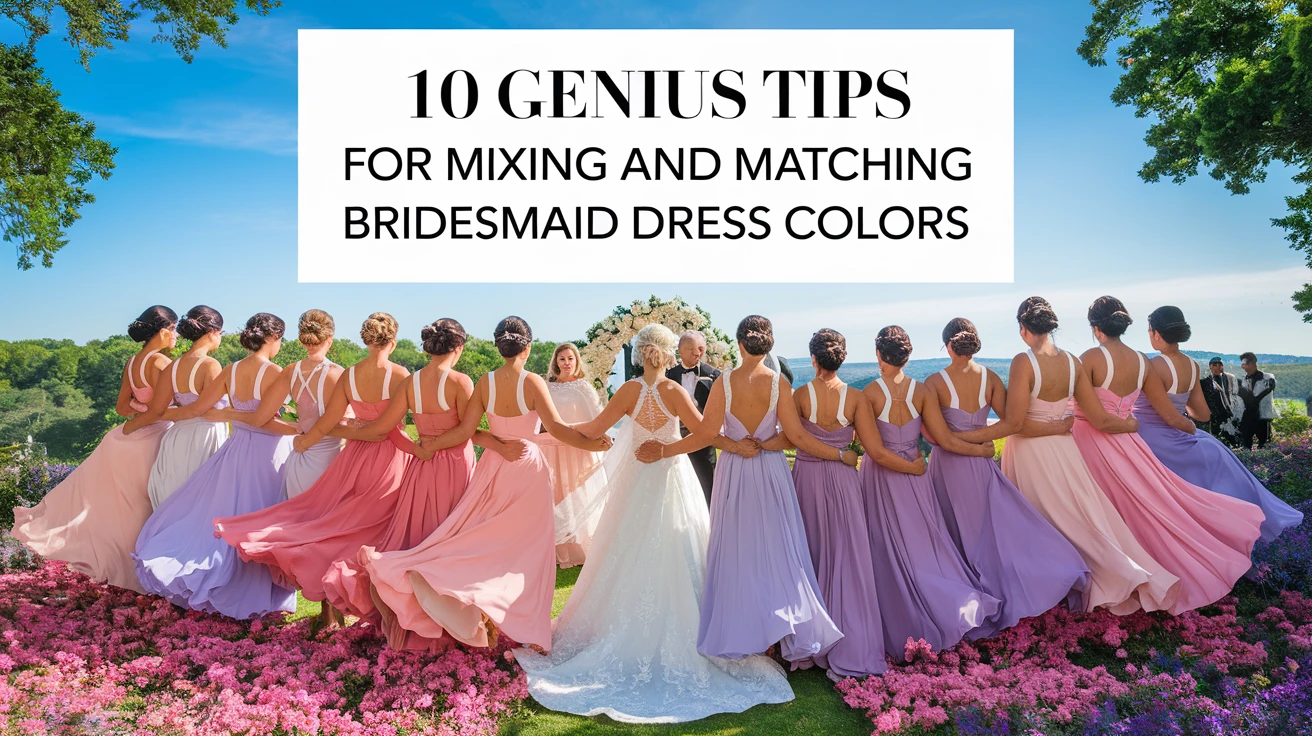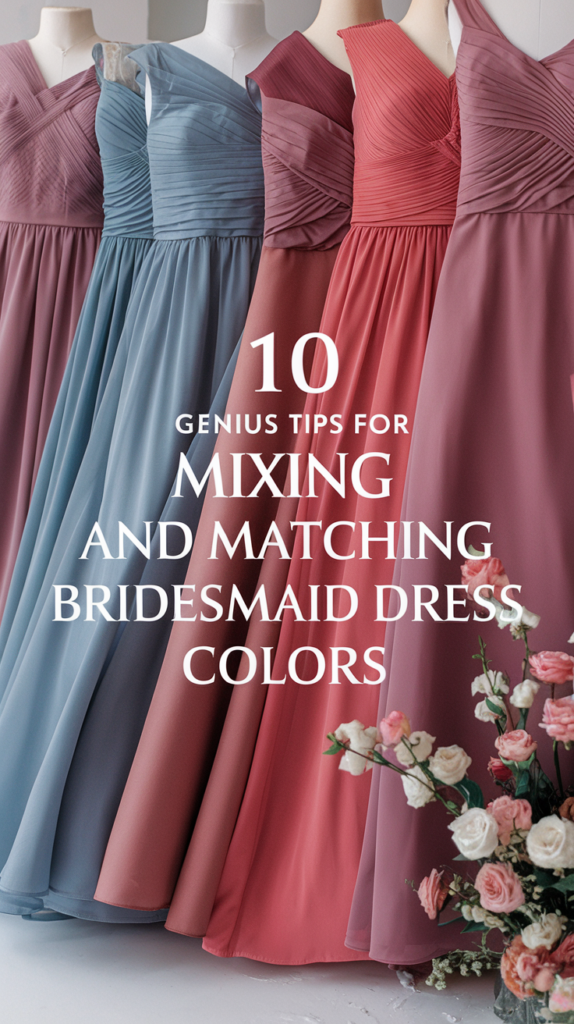
Planning a wedding involves countless decisions, but few are as visually impactful as choosing your bridesmaid dress colors. The trend of mixing and matching bridesmaid dresses has revolutionized modern weddings, offering a fresh take on traditional bridal parties. This approach not only creates stunning visual interest but also allows for individual expression while maintaining a cohesive look. Whether you’re aiming for a subtle gradient of similar hues or a bold combination of complementary colors, mastering the art of mixing and matching bridesmaid dress colors can transform your wedding photos into true works of art. In this comprehensive guide, we’ll explore ten genius tips that will help you create a perfectly coordinated bridal party while avoiding common color mishaps.
1. Understanding Color Theory for Wedding Parties
Before diving into specific combinations, it’s essential to grasp basic color theory principles. The color wheel is your best friend when planning your bridesmaid dress palette. Here’s a breakdown of key color relationships:
- Analogous Colors: These are colors that sit next to each other on the color wheel, creating a harmonious and sophisticated look
- Complementary Colors: Colors opposite each other on the wheel, offering dramatic contrast
- Triadic Colors: Three colors equally spaced around the wheel, providing balance and vibrancy
A personal tip from my experience coordinating weddings: Start with your main wedding color and select two to three additional colors that align with one of these color relationships. This approach has consistently yielded stunning results in dozens of weddings I’ve helped plan.
2. Seasonal Color Palettes That Work
Each season brings its own natural color palette that can inspire your bridesmaid dress selections. Here’s a comprehensive seasonal guide:
| Season | Primary Colors | Accent Colors |
|---|---|---|
| Spring | Soft pinks, lavender, mint | Peach, light blue, sage |
| Summer | Coral, turquoise, yellow | Navy, fuchsia, gold |
| Fall | Burgundy, forest green, rust | Navy, mauve, copper |
| Winter | Deep red, emerald, royal blue | Silver, gold, plum |
3. The Ombre Effect Strategy
One of the most popular and foolproof approaches to mixing and matching bridesmaid dresses is the ombre effect. This technique involves selecting dresses in graduating shades of the same color family. For instance, starting with a deep navy and progressing to lighter blues, or beginning with burgundy and transitioning to blush.
To execute this successfully:
- Choose 3-5 distinct shades within your chosen color family
- Arrange bridesmaids from darkest to lightest (or vice versa)
- Consider height differences when planning the arrangement
- Keep dress styles consistent to maintain focus on the color gradient
4. Complementary Color Combinations
When working with complementary colors, it’s crucial to balance bold choices with neutral elements. Here are some tried-and-true combinations:
| Primary Color | Complement | Neutral Balance |
|---|---|---|
| Dusty Blue | Coral | Gray |
| Sage Green | Mauve | Cream |
| Navy | Blush | Silver |
| Burgundy | Sage | Gold |
5. Working with Neutrals
Neutrals are the unsung heroes of mixed bridesmaid dresses. They can serve as beautiful standalone choices or perfect mediators between bolder hues. Consider these approaches:
- Use champagne or taupe as a binding element between different colors
- Create depth with various shades of gray
- Incorporate metallic neutrals for added sophistication
- Mix warm and cool neutrals for dimensional interest
6. Pattern and Texture Mixing
Don’t forget that mixing and matching isn’t limited to colors alone. Patterns and textures can add incredible depth to your wedding party’s look. Here’s how to do it right:
- Stick to one color family when mixing patterns
- Combine different fabric textures in the same color
- Use sequins or metallics as an accent dress
- Keep patterns scaled appropriately – mix small and large prints
7. Considering Skin Tones
A crucial aspect often overlooked is how different colors complement various skin tones. Here’s a quick guide to flattering color matches:
| Skin Tone | Best Colors | Colors to Avoid |
|---|---|---|
| Fair | Soft blues, pinks, lavender | Bright yellow, orange |
| Medium | Jewel tones, earth tones | Pale pastels |
| Deep | Bold brights, rich jewel tones | Muted pastels |
8. Photography-Friendly Color Schemes
Consider how your chosen colors will photograph. Some colors that look beautiful in person might not translate well in photos. Work with your photographer to understand:
- Which colors photograph best in your chosen venue lighting
- How different fabrics reflect light
- What combinations create the best contrast for photos
- Which colors might appear differently in different lighting conditions
9. Budget-Conscious Color Coordination
Mixing and matching colors can actually help manage the budget for your bridal party. Consider these cost-effective strategies:
- Allow bridesmaids to choose dresses within a specific color palette
- Mix designer dresses with more affordable options in coordinating colors
- Use accessories to tie different colored dresses together
- Consider rental options for specific colors or styles
10. Testing and Sampling Colors
Before making final decisions, it’s crucial to test your color combinations:
- Order fabric swatches from different designers
- Create a digital mood board
- Test colors in different lighting conditions
- Consider how colors will look in both indoor and outdoor settings
Conclusion
Successfully mixing and matching bridesmaid dress colors requires careful planning, consideration of multiple factors, and attention to detail. By following these ten tips, you can create a cohesive, beautiful look that reflects your wedding vision while ensuring your bridesmaids feel comfortable and confident. Remember that while rules and guidelines are helpful, your personal style and preferences should ultimately guide your decisions. The key is to maintain balance while creating a visually interesting and harmonious bridal party appearance that you’ll love looking back on for years to come.
Key Takeaways
- Understanding color theory is fundamental to successful mixing and matching
- Consider seasonal color palettes and your venue when selecting colors
- Take into account skin tones and photography requirements
- Don’t forget to test colors in different lighting conditions
- Balance is key when combining different colors and styles
Frequently Asked Questions
-
How many different colors should I use for bridesmaid dresses?
Generally, stick to 2-4 different colors for a cohesive look. Using more than four colors can make the overall appearance feel chaotic rather than intentionally mixed.
-
Can I mix different dress styles along with different colors?
Yes, you can mix both styles and colors, but it’s recommended to keep one element more consistent than the other to maintain visual harmony.
-
What’s the best way to ensure colors match when ordering from different designers?
Request fabric swatches from all designers you’re considering and compare them in person. Colors can vary significantly between manufacturers and computer screens.
-
Should all bridesmaids wear the same shade if I’m doing an ombre effect?
No, for an ombre effect, each bridesmaid should wear a slightly different shade to create a gradual color progression from light to dark or vice versa.
-
How do I incorporate the maid of honor’s dress when mixing colors?
The maid of honor can either wear a unique color to stand out or wear the darkest/lightest shade in your color scheme to create a natural focal point.
-
Is it appropriate to mix metallic colors with regular colors?
Yes, metallic colors can work beautifully as accent pieces within your color scheme, particularly for evening weddings or formal celebrations.
-
How do I ensure the colors will look good in both indoor and outdoor photos?
Test your chosen colors in both settings and consult with your photographer about how different lighting conditions might affect the colors.
-
Can I use patterns along with solid colors?
Yes, but limit patterns to one or two bridesmaids and ensure the pattern incorporates colors from your chosen palette.
-
How do I handle bridesmaid preferences while maintaining my color scheme?
Provide a range of shades within your chosen color palette and allow bridesmaids to select the shade that best suits their skin tone and preference.
-
What’s the best way to tie different colors together?
Use consistent accessories, bouquets, or complementary makeup looks to create cohesion among different colored dresses.


